Optimized Properties in Multifunctional Polyphenylene Sulfide Composites via Graphene Nanosheets/Boron Nitride Nanosheets Dual Segregated Structure under High Pressure
Abstract
1. Introduction
2. Materials and Methods
2.1. Materials
2.2. Preparation of BN/GNP/PPS Composites
2.3. Characterization
3. Results and Discussion
3.1. Morphological and Structural Analysis
3.2. Thermal Conductive Properties
3.3. Electrical Conductivity and EMI Shielding Performance of PPS Composites
3.4. Tribological, Mechanical and Thermal Properties
4. Conclusions
Supplementary Materials
Author Contributions
Funding
Institutional Review Board Statement
Informed Consent Statement
Data Availability Statement
Conflicts of Interest
References
- Guo, F.M.; Shen, X.; Zhou, J.M.; Liu, D.; Zheng, Q.B.; Yang, J.L.; Jia, B.H.; Lau, A.K.T.; Kim, J.K. Highly thermally conductive dielectric nanocomposites with synergistic alignments of graphene and boron nitride nanosheets. Adv. Funct. Mater. 2020, 30, 1910826. [Google Scholar] [CrossRef]
- Li, X.; Li, C.H.; Zhang, X.M.; Jiang, Y.P.; Xia, L.C.; Wang, J.F.; Song, X.D.; Wu, H.; Guo, S.Y. Simultaneously enhanced thermal conductivity and mechanical properties of PP/BN composites via constructing reinforced segregated structure with a trace amount of BN wrapped PP fiber. Chem. Eng. J. 2020, 390, 124563. [Google Scholar] [CrossRef]
- Nan, B.F.; Wu, K.; Qu, Z.C.; Xiao, L.Q.; Xu, C.G.; Shi, J.; Lu, M.G. A multifunctional thermal management paper based on functionalized graphene oxide nanosheets decorated with nanodiamond. Carbon 2020, 161, 132–145. [Google Scholar] [CrossRef]
- Yuan, Y.; Sun, X.X.; Yang, M.L.; Xu, F.; Lin, Z.S.; Zhao, X.; Ding, Y.J.; Li, J.J.; Yin, W.L.; Peng, Q.Y.; et al. Stiff, thermally stable and highly anisotropic wood-derived carbon composite monoliths for electromagnetic interference shielding. ACS Appl. Mater. Int. 2017, 9, 21371–21381. [Google Scholar] [CrossRef]
- Wang, Z.G.; Yang, Y.L.; Zheng, Z.L.; Lan, R.T.; Dai, K.; Xu, L.; Huang, H.D.; Tang, J.H.; Xu, J.Z.; Li, Z.M. Achieving excellent thermally conductive and electromagnetic shielding performance by nondestructive functionalization and oriented arrangement of carbon nanotubes in composite films. Compos. Sci. Technol. 2020, 194, 108190. [Google Scholar] [CrossRef]
- Li, J.; Wang, Y.; Yue, T.N.; Gao, Y.N.; Shi, Y.D.; Shen, J.B.; Wu, H.; Wang, M. Robust electromagnetic interference shielding, joule heating, thermal conductivity, and anti-dripping performances of polyoxymethylene with uniform distribution and high content of carbon-based nanofillers. Compos. Sci. Technol. 2021, 206, 108681. [Google Scholar] [CrossRef]
- Ren, W.; Yang, Y.Q.; Yang, J.; Duan, H.J.; Zhao, G.Z.; Liu, Y.Q. Multifunctional and corrosion resistant poly(phenylene sulfide)/Ag composites for electromagnetic interference shielding. Chem. Eng. J. 2021, 415, 129052. [Google Scholar] [CrossRef]
- Wang, X.X.; Cao, W.Q.; Cao, M.S.; Yuan, J. Assembling nano-microarchitecture for electromagnetic absorbers and smart devices. Adv. Mater. 2020, 32, 2002112. [Google Scholar] [CrossRef]
- Gorrasi, G.; Bugatti, V.; Milone, C.; Mastronardo, E.; Piperopoulos, E.; Iemmo, L.; Di Bartolomeo, A. Effect of temperature and morphology on the electrical properties of PET/conductive nanofillers composites. Compos. Part B-Eng. 2018, 135, 149–154. [Google Scholar] [CrossRef]
- Yao, T.; Zhou, W.; Peng, W.; Zhou, J.; Li, T.; Wu, H.; Zheng, J.; Lin, N.; Liu, D.; Hou, C. Insights into concomitant enhancements of dielectric properties and thermal conductivity of PVDF composites filled with Core@Double-Shell structured Zn@Zno@PS particles. J. Appl. Polym. Sci. 2022, e53069. [Google Scholar] [CrossRef]
- Liu, H.; Du, H.; Zhao, W.; Qiang, X.; Zheng, B.; Li, Y.; Cao, B. Fast potassium migration in mesoporous carbon with ultrathin framework boosting superior rate performance for high-power potassium storage. Energy Storage Mater. 2021, 40, 490–498. [Google Scholar] [CrossRef]
- Zhou, W.Y.; Li, T.; Yuan, M.X.; Li, B.; Zhong, S.L.; Li, Z.; Liu, X.R.; Zhou, J.J.; Wang, Y.; Cai, H.W.; et al. Decoupling of inter-particle polarization and intra-particle polarization in core-shell structured nanocomposites towards improved dielectric performance. Energy Storage Mater. 2021, 42, 1–11. [Google Scholar] [CrossRef]
- Zhang, Y.L.; Ruan, K.P.; Gu, J.W. Flexible sandwich-structured electromagnetic interference shielding nanocomposite films with excellent thermal conductivities. Small 2021, 17, 2101951. [Google Scholar] [CrossRef]
- Wang, G.; Liao, X.; Yang, J.M.; Tang, W.Y.; Zhang, Y.; Jiang, Q.Y.; Li, G.X. Frequency-selective and tunable electromagnetic shielding effectiveness via the sandwich structure of silicone rubber/graphene composite. Compos. Sci. Technol. 2019, 184, 107847. [Google Scholar] [CrossRef]
- Zhang, L.Q.; Yang, B.; Teng, J.; Lei, J.; Yan, D.X.; Zhong, G.J.; Li, Z.M. Tunable electromagnetic interference shielding effectiveness via multilayer assembly of regenerated cellulose as a supporting substrate and carbon nanotubes/polymer as a functional layer. J. Mater. Chem. C 2017, 5, 3130–3138. [Google Scholar] [CrossRef]
- Zhang, F.D.; Ren, P.G.; Guo, Z.Z.; Wang, J.; Chen, Z.Y.; Zong, Z.; Hu, J.; Jin, Y.L.; Ren, F. Asymmetric multilayered mxene-agnws/cellulose nanofiber composite films with antibacterial properties for high-efficiency electromagnetic interference shielding. J. Mater. Sci. Technol. 2022, 129, 181–189. [Google Scholar] [CrossRef]
- Zhang, L.Q.; Yang, S.G.; Li, L.; Yang, B.; Huang, H.D.; Yan, D.X.; Zhong, G.J.; Xu, L.; Li, Z.M. Ultralight cellulose porous composites with manipulated porous structure and carbon nanotube distribution for promising electromagnetic interference shielding. ACS Appl. Mater. Int. 2018, 10, 40156–40167. [Google Scholar] [CrossRef]
- Zeng, Z.H.; Jin, H.; Chen, M.J.; Li, W.W.; Zhou, L.C.; Xue, X.; Zhang, Z. Microstructure design of lightweight, flexible, and high electromagnetic shielding porous multiwalled carbon nanotube/polymer composites. Small 2017, 13, 1701388. [Google Scholar] [CrossRef]
- Jia, L.; Ding, X.; Sun, J.; Zhang, X.; Tian, X.Y. A controllable gradient structure of hydrophobic composite fabric constructed by silver nanowires and polyvinylidene fluoride microspheres for electromagnetic interference shielding with low reflection. Compos. Part A Appl. Sci. Manuf. 2022, 156, 106884. [Google Scholar] [CrossRef]
- Yan, D.X.; Pang, H.; Li, B.; Vajtai, R.; Xu, L.; Ren, P.G.; Wang, J.H.; Li, Z.M. Structured reduced graphene oxide/polymer composites for ultra-efficient electromagnetic interference shielding. Adv. Funct. Mater. 2015, 25, 559–566. [Google Scholar] [CrossRef]
- Hu, Y.L.; Feng, D.; Xie, Y.H.; Xie, D.L. Microwave-assisted confining flame-retardant polypropylene in carbon nanotube conductive networks for improved electromagnetic interference shielding and flame retardation. Adv. Funct. Mater. 2021, 23, 2100024. [Google Scholar] [CrossRef]
- Jia, L.C.; Yan, D.X.; Cui, C.H.; Jiang, X.; Ji, X.; Li, Z.M. Electrically conductive and electromagnetic interference shielding of polyethylene composites with devisable carbon nanotube networks. J. Mater. Chem. C 2015, 3, 9369–9378. [Google Scholar] [CrossRef]
- Gao, C.; Lu, H.; Ni, H.; Chen, J. Structure, thermal conductive, dielectric and electrical insulating properties of UHMWPE/BN composites with a segregated structure. J. Polym. Res. 2017, 25, 6. [Google Scholar] [CrossRef]
- Wang, Z.G.; Gong, F.; Yu, W.C.; Huang, Y.F.; Zhu, L.; Lei, J.; Xu, J.Z.; Li, Z.M. Synergetic enhancement of thermal conductivity by constructing hybrid conductive network in the segregated polymer composites. Compos. Sci. Technol. 2018, 162, 7–13. [Google Scholar] [CrossRef]
- Zhou, H.; Deng, H.; Zhang, L.; Fu, Q. Significant enhancement of thermal conductivity in polymer composite via constructing macroscopic segregated filler networks. ACS Appl. Mater. Int. 2017, 9, 29071–29081. [Google Scholar] [CrossRef]
- Liang, C.B.; Ruan, K.P.; Zhang, Y.L.; Gu, J.W. Multifunctional flexible electromagnetic interference shielding silver nanowires/cellulose films with excellent thermal management and joule heating performances. ACS Appl. Mater. Int. 2020, 12, 18023–18031. [Google Scholar] [CrossRef]
- Zhao, B.; Zhao, C.X.; Li, R.S.; Hamidinejad, S.M.; Park, C.B. Flexible, ultrathin, and high-efficiency electromagnetic shielding properties of poly(vinylidene fluoride)/carbon composite films. ACS Appl. Mater. Int. 2017, 9, 20873–20884. [Google Scholar] [CrossRef]
- Pawar, S.P.; Stephen, S.; Bose, S.; Mittal, V. Tailored electrical conductivity, electromagnetic shielding and thermal transport in polymeric blends with graphene sheets decorated with nickel nanoparticles. Phys. Chem. Chem. Phys. 2015, 17, 14922–14930. [Google Scholar] [CrossRef]
- Ren, F.; Song, D.P.; Li, Z.; Jia, L.C.; Zhao, Y.C.; Yan, D.X.; Ren, P.G. Synergistic effect of graphene nanosheets and carbonyl iron-nickel alloy hybrid filler on electromagnetic interference shielding and thermal conductivity of cyanate ester composites. J. Mater. Chem. C 2018, 6, 1476–1486. [Google Scholar] [CrossRef]
- Lin, S.F.; Ju, S.; Zhang, J.W.; Shi, G.; He, Y.L.; Jiang, D.Z. Ultrathin flexible graphene films with high thermal conductivity and excellent EMI shielding performance using large-sized graphene oxide flakes. RSC Adv. 2019, 9, 1419–1427. [Google Scholar] [CrossRef]
- Liu, H.B.; Fu, R.L.; Su, X.Q.; Wu, B.Y.; Wang, H.; Xu, Y.; Liu, X.H. Electrical insulating Mxene/PDMS/BN composite with enhanced thermal conductivity for electromagnetic shielding application. Compos. Commun. 2021, 23, 100593. [Google Scholar] [CrossRef]
- Raagulan, K.; Braveenth, R.; Kim, B.M.; Lim, K.J.; Lee, S.B.; Kim, M.; Chai, K.Y. An effective utilization of Mxene and its effect on electromagnetic interference shielding: Flexible, free-standing and thermally conductive composite from Mxene-PAT-Poly(P-Aminophenol)-Polyaniline co-polymer. RSC Adv. 2020, 10, 1613–1633. [Google Scholar] [CrossRef] [PubMed]
- Yu, J.C.; Sundqvist, B.; Tonpheng, B.; Andersson, O. Thermal conductivity of highly crystallized polyethylene. Polymer 2014, 55, 195–200. [Google Scholar] [CrossRef]
- Wang, J.; Hopmann, C.; Schmitz, M.; Hohlweck, T. Influence of measurement processes on pressure-specific volume-temperature relationships of semi-crystalline polymer: Polypropylene. Polym. Test. 2019, 78, 105992. [Google Scholar] [CrossRef]
- Gere, D.; Czigany, T. Rheological and mechanical properties of recycled polyethylene films contaminated by biopolymer. Waste Manag. 2018, 76, 190–198. [Google Scholar] [CrossRef]
- Xu, H.L.; Yin, X.W.; Li, X.L.; Li, M.H.; Liang, S.; Zhang, L.T.; Cheng, L.F. Lightweight Ti2CTx MXene/Poly(vinyl alcohol) composite foams for electromagnetic wave shielding with absorption-dominated feature. ACS Appl. Mater. Int. 2019, 11, 10198–10207. [Google Scholar] [CrossRef]
- Cui, C.H.; Yan, D.X.; Pang, H.; Xu, X.; Jia, L.C.; Li, Z.M. Formation of a Segregated Electrically Conductive Network Structure in a Low-Melt-Viscosity Polymer for Highly Efficient Electromagnetic Interference Shielding. ACS Sustain. Chem. Eng. 2016, 4, 4137–4145. [Google Scholar] [CrossRef]
- Chen, J.; Liao, X.; Xiao, W.; Yang, J.M.; Jiang, Q.Y.; Li, G.X. Facile and Green Method To Structure Ultralow-Threshold and Lightweight Polystyrene/MWCNT Composites with Segregated Conductive Networks for Efficient Electromagnetic Interference Shielding. ACS Sustain. Chem. Eng. 2019, 7, 9904–9915. [Google Scholar] [CrossRef]
- Duan, H.J.; Xu, Y.D.; Yan, D.X.; Yang, Y.Q.; Zhao, G.Z.; Liu, Y.Q. Ultrahigh molecular weight polyethylene composites with segregated nickel conductive network for highly efficient electromagnetic interference shielding. Mater. Lett. 2017, 209, 353–356. [Google Scholar] [CrossRef]
- Duan, H.J.; Zhu, H.X.; Yang, Y.Q.; Hou, T.T.; Zhao, G.Z.; Liu, Y.Q. Facile and economical fabrication of conductive polyamide 6 composites with segregated expanded graphite networks for efficient electromagnetic interference shielding. J. Mater. Sci. Mater. Electron. 2018, 29, 1058–1064. [Google Scholar] [CrossRef]
- Fang, H.G.; Ye, W.J.; Yang, K.J.; Song, K.; Wei, H.B.; Ding, Y.S. Vitrimer chemistry enables epoxy nanocomposites with mechanical robustness and integrated conductive segregated structure for high performance electromagnetic interference shielding. Compos. B Eng. 2021, 215, 108782. [Google Scholar] [CrossRef]
- Gao, C.Q.; Shi, Y.Q.; Chen, Y.J.; Zhu, S.C.; Feng, Y.Z.; Lv, Y.C.; Yang, F.Q.; Liu, M.H.; Shui, W. Constructing segregated polystyrene composites for excellent fire resistance and electromagnetic wave shielding. J. Colloid Interface Sci. 2022, 606, 1193–1204. [Google Scholar] [CrossRef] [PubMed]
- Ge, C.B.A.; Wang, G.L.; Zhao, G.Q.; Wei, C.; Li, X.Y. Lightweight and flexible poly(ether-block-amide)/multiwalled carbon nanotube composites with porous structure and segregated conductive networks for electromagnetic shielding applications. Compos. A Appl. Sci. Manuf. 2021, 144, 106356. [Google Scholar] [CrossRef]
- Jia, L.C.; Yan, D.X.; Jiang, X.; Pang, H.; Gao, J.F.; Ren, P.G.; Li, Z.M. Synergistic Effect of Graphite and Carbon Nanotubes on Improved Electromagnetic Interference Shielding Performance in Segregated Composites. Ind. Eng. Chem. Res. 2018, 57, 11929–11938. [Google Scholar] [CrossRef]
- Li, T.; Zhao, G.; Zhang, L.; Wang, G.; Li, B.; Gong, J. Ultralow-threshold and efficient EMI shielding PMMA/MWCNTs composite foams with segregated conductive network and gradient cells. Express Polym. Lett. 2020, 14, 685–703. [Google Scholar] [CrossRef]
- Sharif, F.; Arjmand, M.; Moud, A.A.; Sundararaj, U.; Roberts, E.P.L. Segregated Hybrid Poly(methyl methacrylate)/Graphene/Magnetite Nanocomposites for Electromagnetic Interference Shielding. ACS Appl. Mater. Interfaces 2017, 9, 14171–14179. [Google Scholar] [CrossRef]
- Tang, X.H.; Tang, Y.; Wang, Y.; Weng, Y.X.; Wang, M. Interfacial metallization in segregated poly (lactic acid)/poly (e-caprolactone)/multi-walled carbon nanotubes composites for enhancing electromagnetic interference shielding. Compos. A Appl. Sci. Manuf. 2020, 139, 106116. [Google Scholar] [CrossRef]
- Wang, G.L.; Wang, L.; Mark, L.H.; Shaayegan, V.; Wang, G.Z.; Li, H.P.; Zhao, G.Q.; Park, C.B. Ultralow-Threshold and Lightweight Biodegradable Porous PLA/MWCNT with Segregated Conductive Networks for High-Performance Thermal Insulation and Electromagnetic Interference Shielding Applications. ACS Appl. Mater. Interfaces 2018, 10, 1195–1203. [Google Scholar] [CrossRef]
- Wang, H.; Zheng, K.; Zhang, X.; Du, T.X.; Xiao, C.; Ding, X.; Bao, C.; Chen, L.; Tian, X.Y. Segregated poly(vinylidene fluoride)/MWCNTs composites for high-performance electromagnetic interference shielding. Compos. A Appl. Sci. Manuf. 2016, 90, 606–613. [Google Scholar] [CrossRef]
- Wang, T.; Kong, W.W.; Yu, W.C.; Gao, J.F.; Dai, K.; Yan, D.X.; Li, Z.M. A Healable and Mechanically Enhanced Composite with Segregated Conductive Network Structure for High-Efficient Electromagnetic Interference Shielding. Nano-Micro Lett. 2021, 13, 1–14. [Google Scholar] [CrossRef]
- Wang, T.; Yu, W.C.; Sun, W.J.; Jia, L.C.; Gao, J.F.; Tang, J.H.; Su, H.J.; Yan, D.X.; Li, Z.M. Healable polyurethane/carbon nanotube composite with segregated structure for efficient electromagnetic interference shielding. Compos. Sci. Technol. 2020, 200, 108446. [Google Scholar] [CrossRef]
- Wu, H.Y.; Jia, L.C.; Yan, D.X.; Gao, J.F.; Zhang, X.P.; Ren, P.G.; Li, Z.M. Simultaneously improved electromagnetic interference shielding and mechanical performance of segregated carbon nanotube/polypropylene composite via solid phase molding. Compos. Sci. Technol. 2018, 156, 87–94. [Google Scholar] [CrossRef]
- Yan, D.X.; Pang, H.; Xu, L.; Bao, Y.; Ren, P.G.; Lei, J.; Li, Z.M. Electromagnetic interference shielding of segregated polymer composite with an ultralow loading of in situ thermally reduced graphene oxide. Nanotechnology 2014, 25, 145705. [Google Scholar] [CrossRef] [PubMed]
- Yu, W.C.; Wang, T.; Zhang, G.Q.; Wang, Z.G.; Yin, H.M.; Yan, D.X.; Xu, J.Z.; Li, Z.M. Largely enhanced mechanical property of segregated carbon nanotube/poly (vinylidene fluoride) composites with high electromagnetic interference shielding performance. Compos. Sci. Technol. 2018, 167, 260–267. [Google Scholar] [CrossRef]
- Yu, W.C.; Zhang, G.Q.; Liu, Y.H.; Xu, L.; Yan, D.X.; Huang, H.D.; Tang, J.H.; Xu, J.Z.; Li, Z.M. Selective electromagnetic interference shielding performance and superior mechanical strength of conductive polymer composites with oriented segregated conductive networks. Chem. Eng. J. 2019, 373, 556–564. [Google Scholar] [CrossRef]
- Yuan, D.; Guo, H.C.; Ke, K.; Manas-Zloczower, I. Recyclable conductive epoxy composites with segregated filler network structure for EMI shielding and strain sensing. Compos. A Appl. Sci. Manuf. 2020, 132, 105837. [Google Scholar] [CrossRef]
- Zhang, K.; Li, G.H.; Feng, L.M.; Wang, N.; Guo, J.; Sun, K.; Yu, K.X.; Zeng, J.B.; Li, T.X.; Guo, Z.H.; et al. Ultralow percolation threshold and enhanced electromagnetic interference shielding in poly(L-lactide)/multi-walled carbon nanotube nanocomposites with electrically conductive segregated networks. J. Mater. Chem. C 2017, 5, 9359–9369. [Google Scholar] [CrossRef]
- Zhang, K.; Yu, H.O.; Yu, K.X.; Gao, Y.; Wang, M.; Li, J.; Guo, S.Y. A facile approach to constructing efficiently segregated conductive networks in poly(lactic acid)/silver nanocomposites via silver plating on microfibers for electromagnetic interference shielding. Compos. Sci. Technol. 2018, 156, 136–143. [Google Scholar] [CrossRef]
- Zhang, X.P.; Jia, L.C.; Zhang, G.; Yan, D.X.; Li, Z.M. A highly efficient and heat- resistant electromagnetic interference shielding carbon nanotube/poly( phenylene sulfide) composite via sinter molding. J. Mater. Chem. C 2018, 6, 10760–10766. [Google Scholar] [CrossRef]
- Chaudhary, A.; Kumar, R.; Dhakate, S.R.; Kumari, S. Scalable development of a multi-phase thermal management system with superior EMI shielding properties. Compos. B Eng. 2019, 158, 206–217. [Google Scholar] [CrossRef]
- Chaudhary, A.; Teotia, S.; Kumar, R.; Gupta, V.; Dhakate, S.R.; Kumari, S. Multi-component framework derived SiC composite paper to support efficient thermal transport and high EMI shielding performance. Compos. B Eng. 2019, 176, 107123. [Google Scholar] [CrossRef]
- Guo, Y.Q.; Pan, L.L.; Yang, X.T.; Ruan, K.P.; Han, Y.X.; Kong, J.; Gu, J.W. Simultaneous improvement of thermal conductivities and electromagnetic interference shielding performances in polystyrene composites via constructing interconnection oriented networks based on electrospinning technology. Compos. A Appl. Sci. Manuf. 2019, 124, 105484. [Google Scholar] [CrossRef]
- Jin, X.X.; Wang, J.F.; Dai, L.Z.; Liu, X.Y.; Li, L.; Yang, Y.Y.; Cao, Y.X.; Wang, W.J.; Wu, H.; Guo, S.Y. Flame-retardant poly(vinyl alcohol)/MXene multilayered films with outstanding electromagnetic interference shielding and thermal conductive performances. Chem. Eng. J. 2020, 380, 122475. [Google Scholar] [CrossRef]
- Kim, J.M.; Lee, Y.; Jang, M.G.; Han, C.; Kim, W.N. Electrical conductivity and EMI shielding effectiveness of polyurethane foam-conductive filler composites. J. Appl. Polym. Sci. 2017, 134, 44373. [Google Scholar] [CrossRef]
- Li, J.C.; Zhao, X.Y.; Wu, W.J.; Ji, X.W.; Lu, Y.L.; Zhang, L.Q. Bubble-templated rGO-graphene nanoplatelet foams encapsulated in silicon rubber for electromagnetic interference shielding and high thermal conductivity. Chem. Eng. J. 2021, 415, 129054. [Google Scholar] [CrossRef]
- Li, J.P.; Qi, S.H.; Zhang, M.Y.; Wang, Z.F. Thermal conductivity and electromagnetic shielding effectiveness of composites based on Ag-plating carbon fiber and epoxy. J. Appl. Polym. Sci. 2015, 132, 42306. [Google Scholar] [CrossRef]
- Liang, C.B.; Qiu, H.; Han, Y.Y.; Gu, H.B.; Song, P.; Wang, L.; Kong, J.; Cao, D.P.; Gu, J.W. Superior electromagnetic interference shielding 3D graphene nanoplatelets/reduced graphene oxide foam/epoxy nanocomposites with high thermal conductivity. J. Mater. Chem. C 2019, 7, 2725–2733. [Google Scholar] [CrossRef]
- Liang, C.Y.; Hamidinejad, M.; Ma, L.; Wang, Z.J.; Park, C.B. Lightweight and flexible graphene/SiC-nanowires/poly(vinylidene fluoride) composites for electromagnetic interference shielding and thermal management. Carbon 2020, 156, 58–66. [Google Scholar] [CrossRef]
- Liang, L.Y.; Xu, P.H.; Wang, Y.F.; Shang, Y.; Ma, J.M.; Su, F.M.; Feng, Y.Z.; He, C.G.; Wang, Y.M.; Liu, C.T. Flexible polyvinylidene fluoride film with alternating oriented graphene/Ni nanochains for electromagnetic interference shielding and thermal management. Chem. Eng. J. 2020, 395, 125209. [Google Scholar] [CrossRef]
- Liu, C.; Wu, W.; Wang, Y.; Wang, Z.Y.; Chen, Q.M. Silver-coated thermoplastic polyurethane hybrid granules for dual-functional elastomer composites with exceptional thermal conductive and electromagnetic interference shielding performances. Compos. Commun. 2021, 25, 100719. [Google Scholar] [CrossRef]
- Shen, Z.M.; Feng, J.C. Preparation of Thermally Conductive Polymer Composites with Good Electromagnetic Interference Shielding Efficiency Based on Natural Wood-Derived Carbon Scaffolds. ACS Sustain. Chem. Eng. 2019, 7, 6259–6266. [Google Scholar] [CrossRef]
- Shi, H.G.; Zhao, H.B.; Liu, B.W.; Wang, Y.Z. Multifunctional Flame-Retardant Melamine-Based Hybrid Foam for Infrared Stealth, Thermal Insulation, and Electromagnetic Interference Shielding. ACS Appl. Mater. Interfaces 2021, 13, 26505–26514. [Google Scholar] [CrossRef] [PubMed]
- Song, P.; Liu, B.; Liang, C.B.; Ruan, K.P.; Qiu, H.; Ma, Z.L.; Guo, Y.Q.; Gu, J.W. Lightweight, Flexible Cellulose-Derived Carbon Aerogel@Reduced Graphene Oxide/PDMS Composites with Outstanding EMI Shielding Performances and Excellent Thermal Conductivities. Nano-Micro Lett. 2021, 13, 1–17. [Google Scholar] [CrossRef] [PubMed]
- Wang, L.; Qiu, H.; Liang, C.B.; Song, P.; Han, Y.X.; Han, Y.X.; Gu, J.W.; Kong, J.; Pan, D.; Guo, Z.H. Electromagnetic interference shielding MWCNT-Fe3O4@Ag/epoxy nanocomposites with satisfactory thermal conductivity and high thermal stability. Carbon 2019, 141, 506–514. [Google Scholar] [CrossRef]
- Wang, Y.; Wang, W.; Xu, R.; Zhu, M.F.; Yu, D. Flexible, durable and thermal conducting thiol-modified rGO-WPU/cotton fabric for robust electromagnetic interference shielding. Chem. Eng. J. 2019, 360, 817–828. [Google Scholar] [CrossRef]
- Wei, L.F.; Ma, J.Z.; Zhang, W.B.; Bai, S.L.; Ren, Y.N.; Zhang, L.; Wu, Y.K.; Qin, J.B. pH triggered hydrogen bonding for preparing mechanically strong, electromagnetic interference shielding and thermally conductive waterborne polymer/graphene@polydopamine composites. Carbon 2021, 181, 212–224. [Google Scholar] [CrossRef]
- Yang, X.T.; Fan, S.G.; Li, Y.; Guo, Y.Q.; Li, Y.G.; Ruan, K.P.; Zhang, S.M.; Zhang, J.L.; Kong, J.; Gu, J.W. Synchronously improved electromagnetic interference shielding and thermal conductivity for epoxy nanocomposites by constructing 3D copper nanowires/thermally annealed graphene aerogel framework. Compos. A Appl. Sci. Manuf. 2020, 128, 105670. [Google Scholar] [CrossRef]
- Zhan, Y.H.; Cheng, Y.; Yan, N.; Li, Y.C.; Meng, Y.Y.; Zhang, C.M.; Chen, Z.M.; Xia, H.S. Lightweight and self-healing carbon nanotube/acrylic copolymer foams: Toward the simultaneous enhancement of electromagnetic interference shielding and thermal insulation. Chem. Eng. J. 2021, 417, 129339. [Google Scholar] [CrossRef]
- Zhang, H.M.; Zhang, G.C.; Gao, Q.; Tang, M.; Ma, Z.L.; Qin, J.B.; Wang, M.Y.; Kim, J.K. Multifunctional microcellular PVDF/Ni-chains composite foams with enhanced electromagnetic interference shielding and superior thermal insulation performance. Chem. Eng. J. 2020, 379, 122304. [Google Scholar] [CrossRef]
- Zhou, B.; Li, Q.T.; Xu, P.H.; Feng, Y.Z.; Ma, J.M.; Liu, C.T.; Shen, C.Y. An asymmetric sandwich structural cellulose-based film with self-supported MXene and AgNW layers for flexible electromagnetic interference shielding and thermal management. Nanoscale 2021, 13, 2378–2388. [Google Scholar] [CrossRef]
- Zong, Z.; Ren, F.; Guo, Z.Z.; Lu, Z.X.; Jin, Y.L.; Zhao, Y.C.; Ren, P.G. Dual-functional carbonized loofah@GNSs-CNTs reinforced by cyanate ester composite with highly efficient electromagnetic interference shielding and thermal management. Compos. B Eng. 2021, 223, 109132. [Google Scholar] [CrossRef]
- Yuan, Y.; Liu, L.Y.; Yang, M.L.; Zhang, T.L.; Xu, F.; Lin, Z.S.; Ding, Y.J.; Wang, C.H.; Li, J.J.; Yin, W.L.; et al. Lightweight, thermally insulating and stiff carbon honeycomb-induced graphene composite foams with a horizontal laminated structure for electromagnetic interference shielding. Carbon 2017, 123, 223–232. [Google Scholar] [CrossRef]
- Guo, Y.L.; Zhang, R.Z.; Wu, K.; Chen, F.; Fu, Q. Preparation of Nylon MXD6/EG/CNTs Ternary Composites with Excellent Thermal Conductivity and Electromagnetic Interference Shielding Effectiveness. Chin. J. Polym. Sci. 2017, 35, 1497–1507. [Google Scholar] [CrossRef]
- Li, Y.; Xu, F.; Lin, Z.S.; Sun, X.X.; Peng, Q.Y.; Yuan, Y.; Wang, S.S.; Yang, Z.Y.; He, X.D.; Li, Y.B. Electrically and thermally conductive underwater acoustically absorptive graphene/rubber nanocomposites for multifunctional applications. Nanoscale 2017, 9, 14476–14485. [Google Scholar] [CrossRef]
- Liu, P.S.; Qing, H.B.; Hou, H.L.; Wang, Y.Q.; Zhang, Y.L. EMI shielding and thermal conductivity of a high porosity reticular titanium foam. Mater. Des. 2016, 92, 823–828. [Google Scholar] [CrossRef]
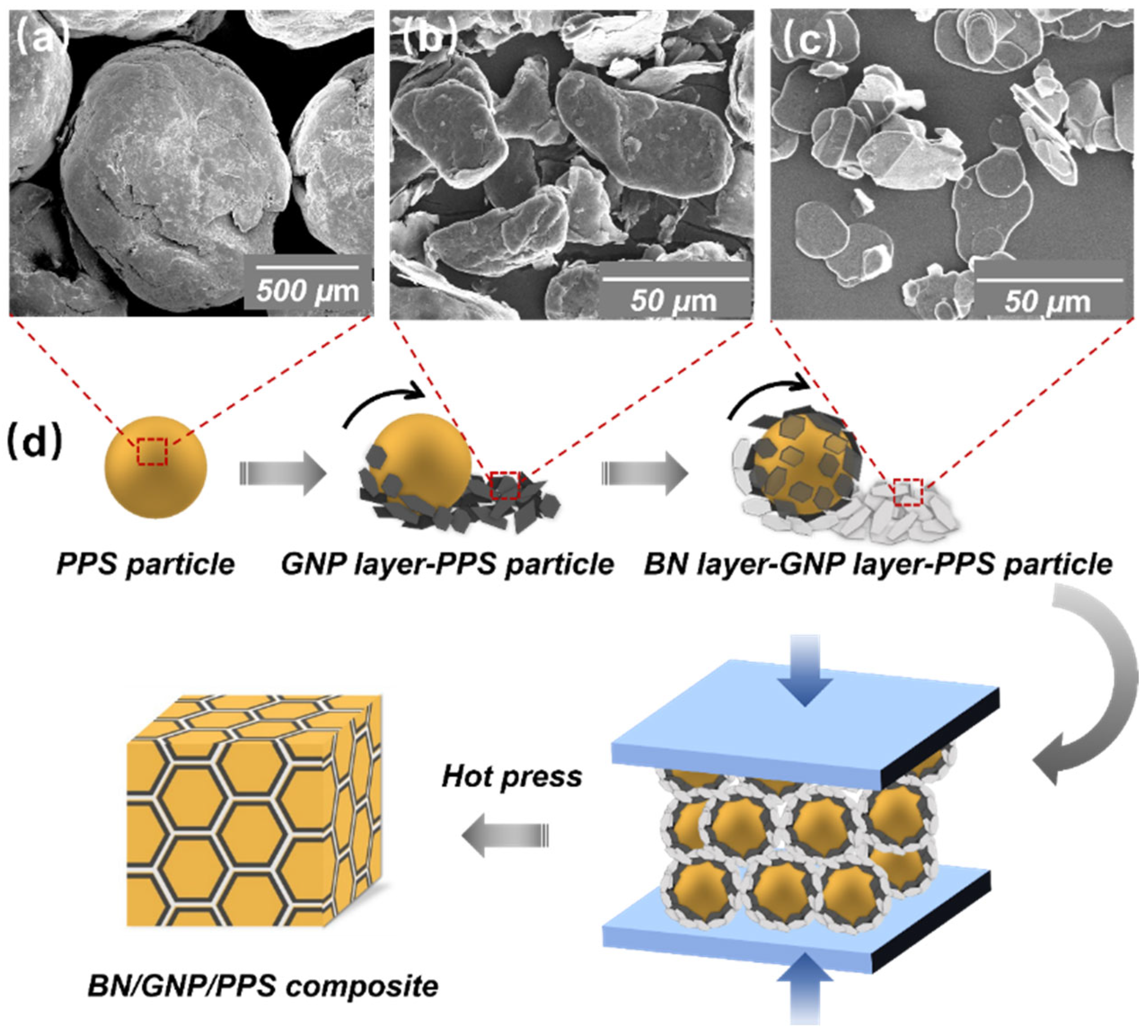
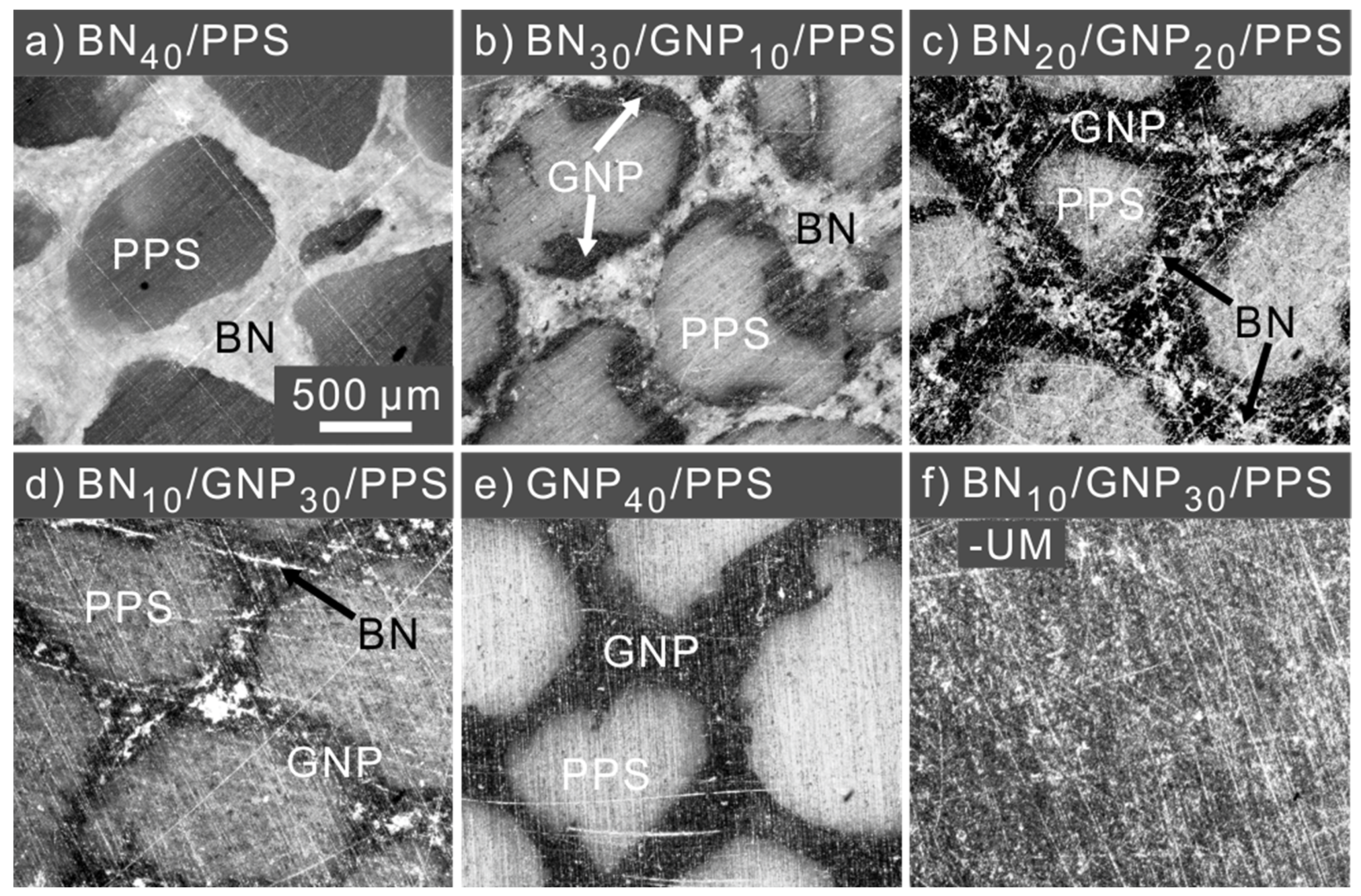
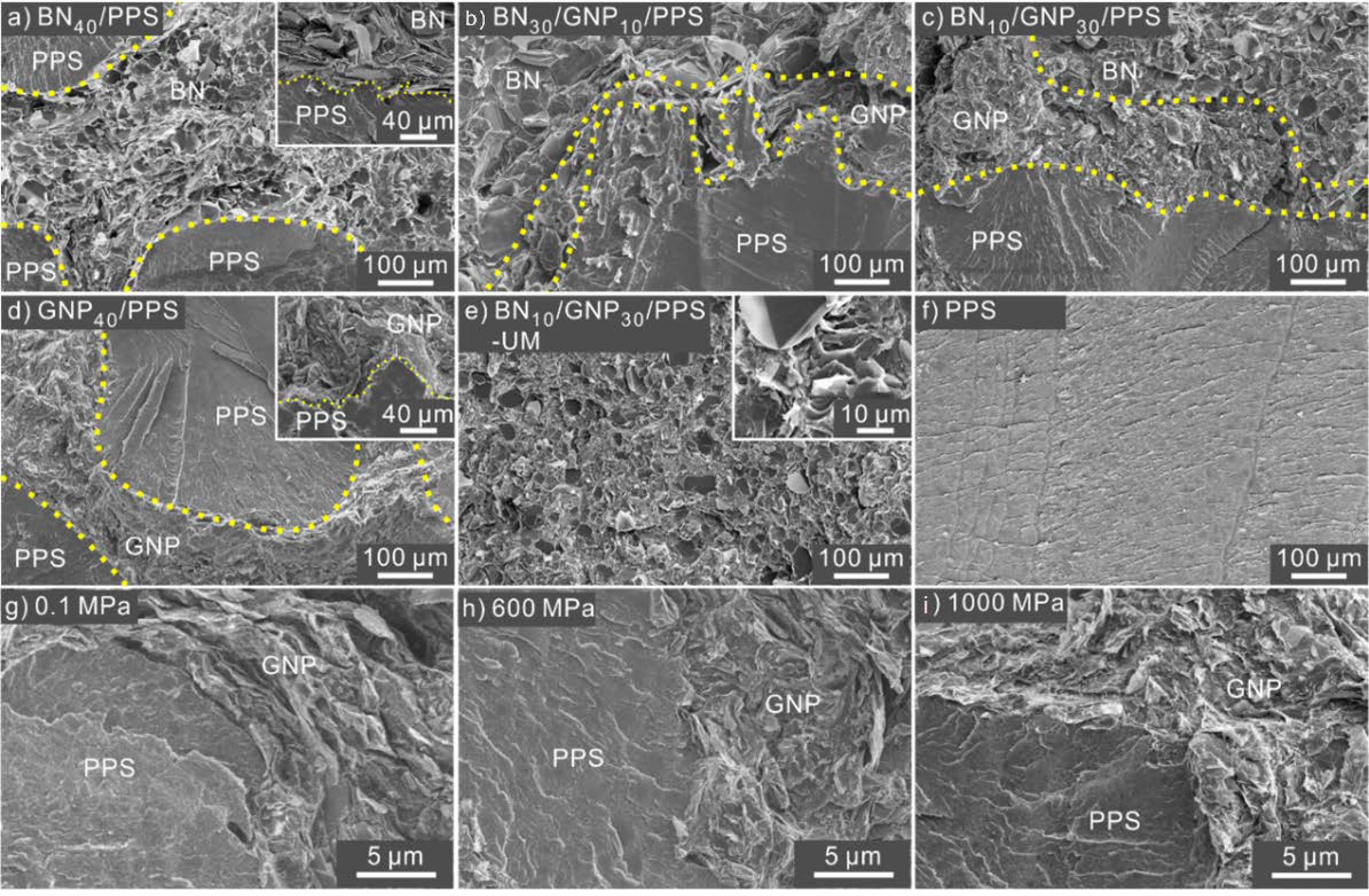
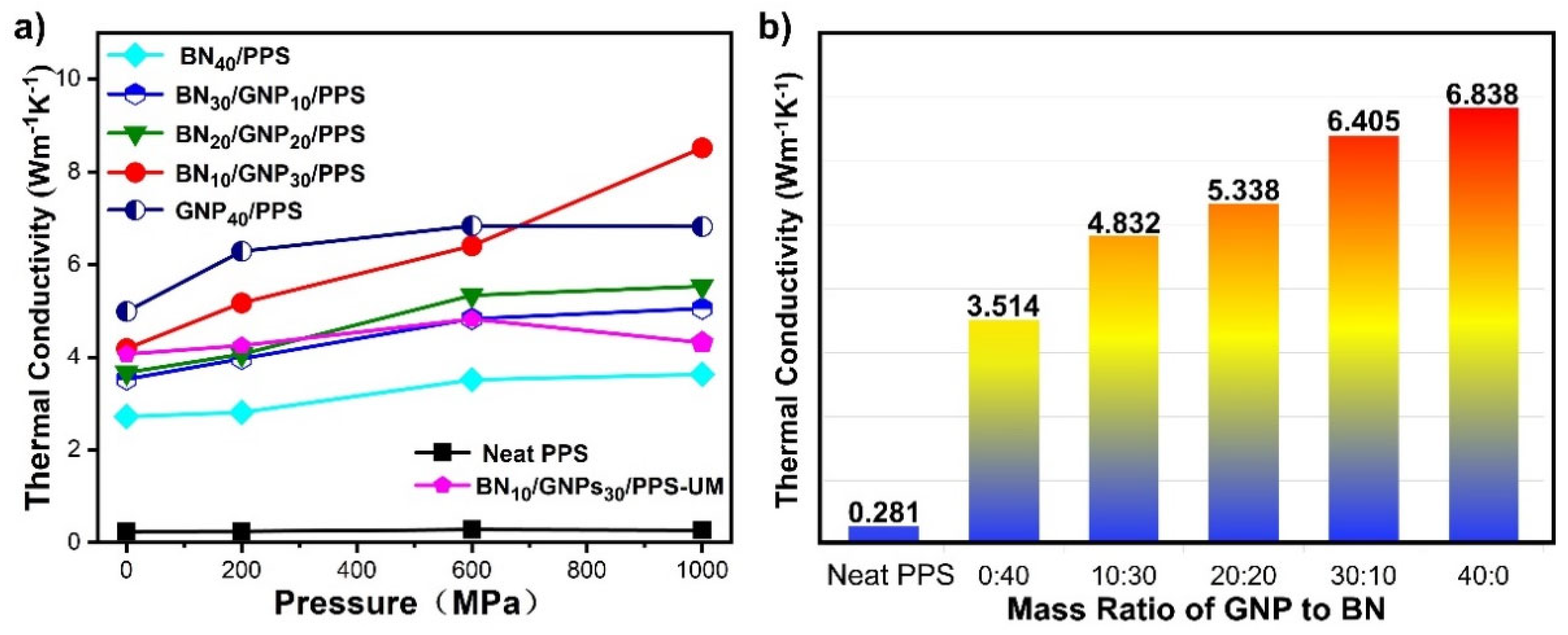
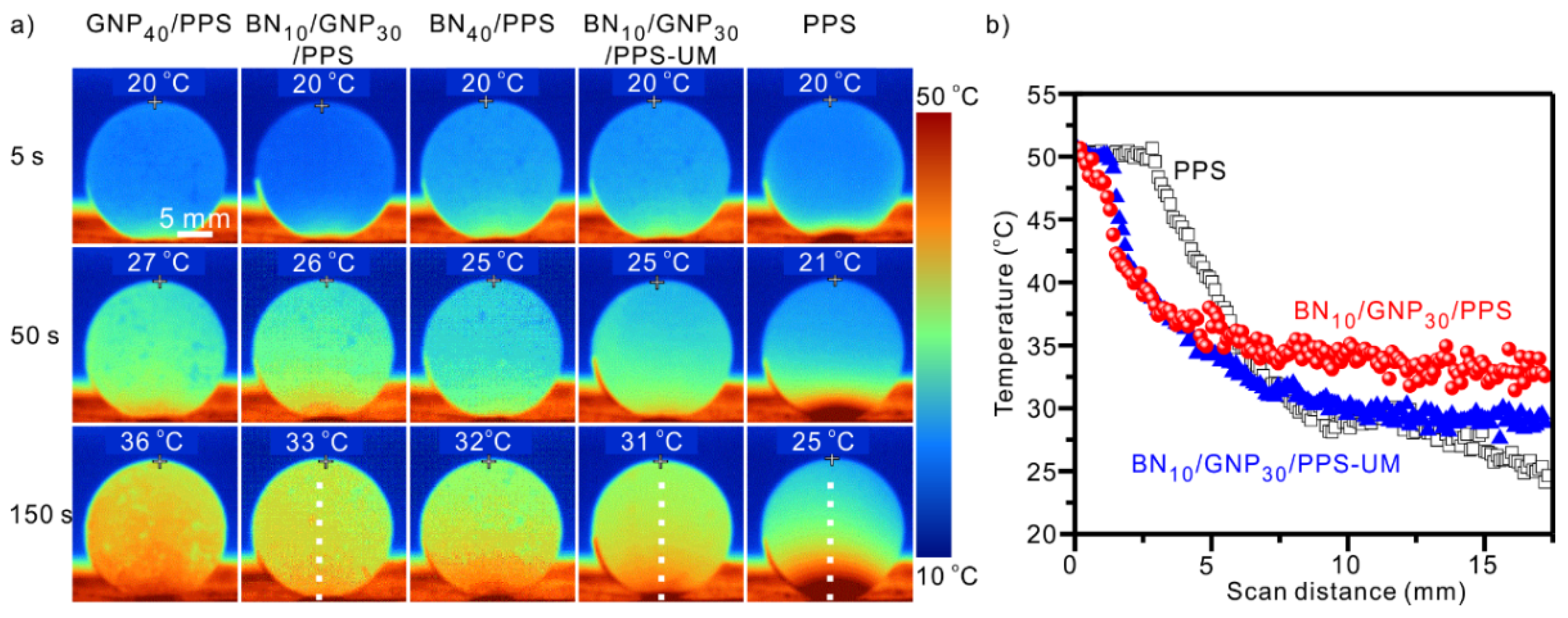
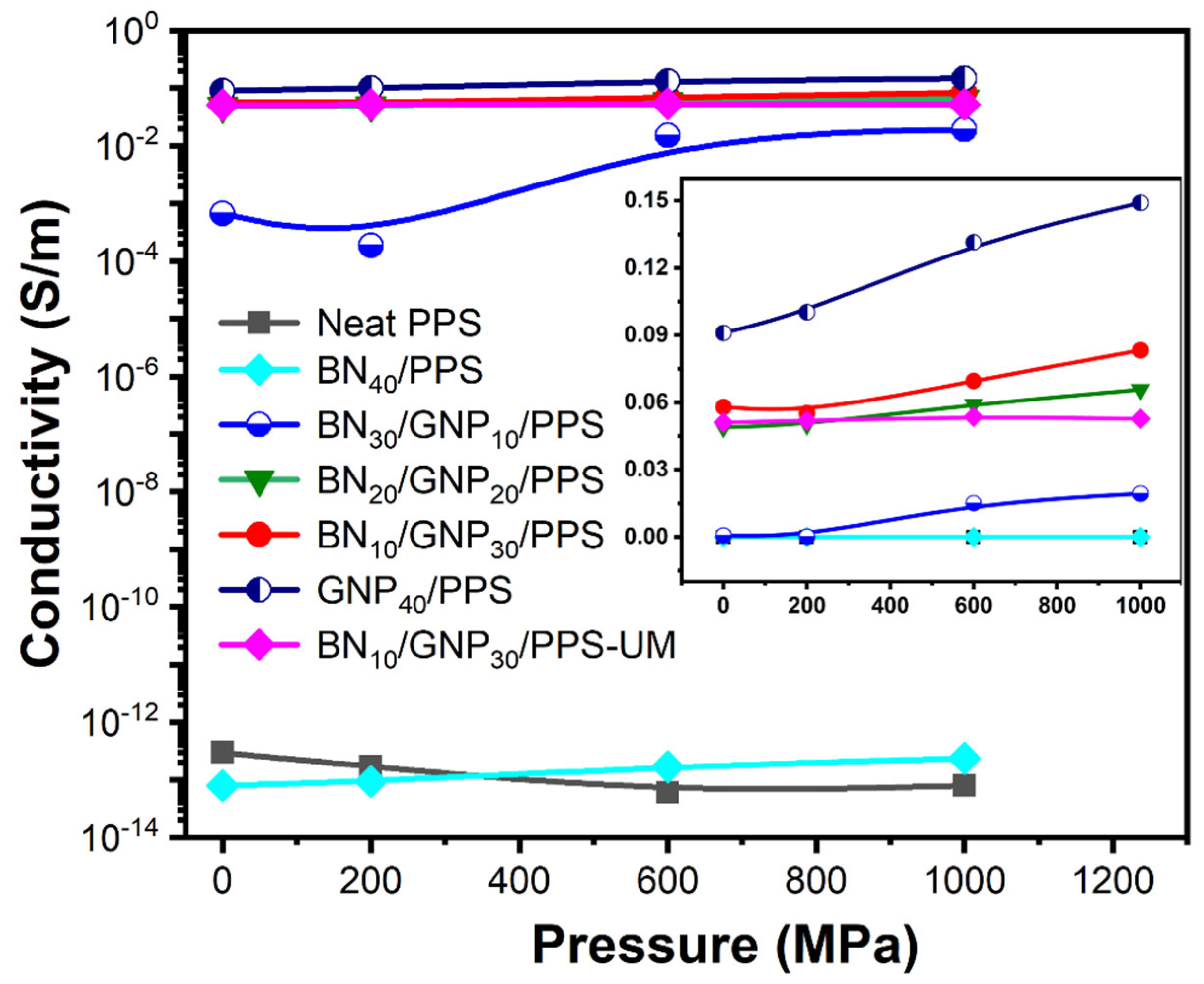
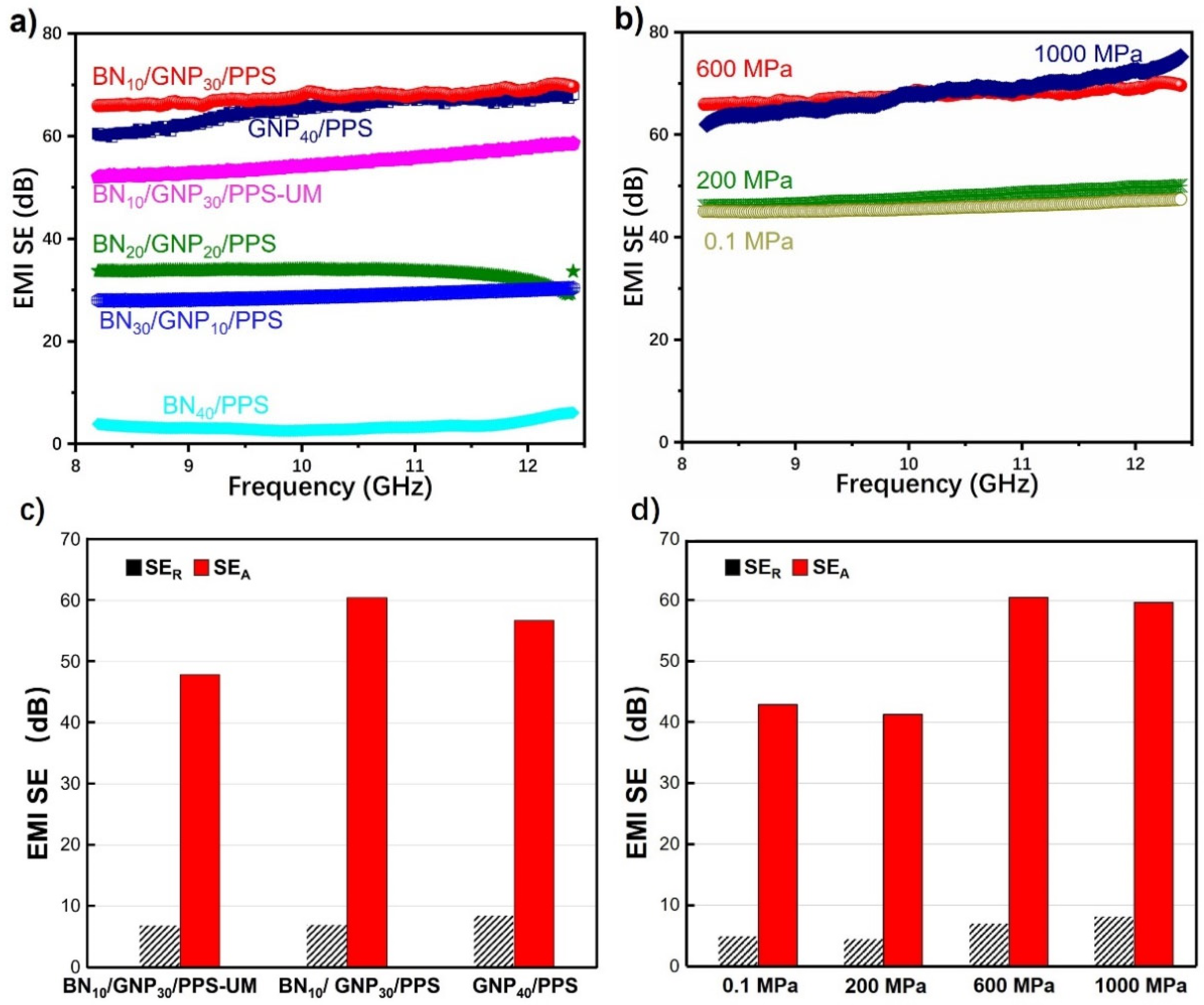
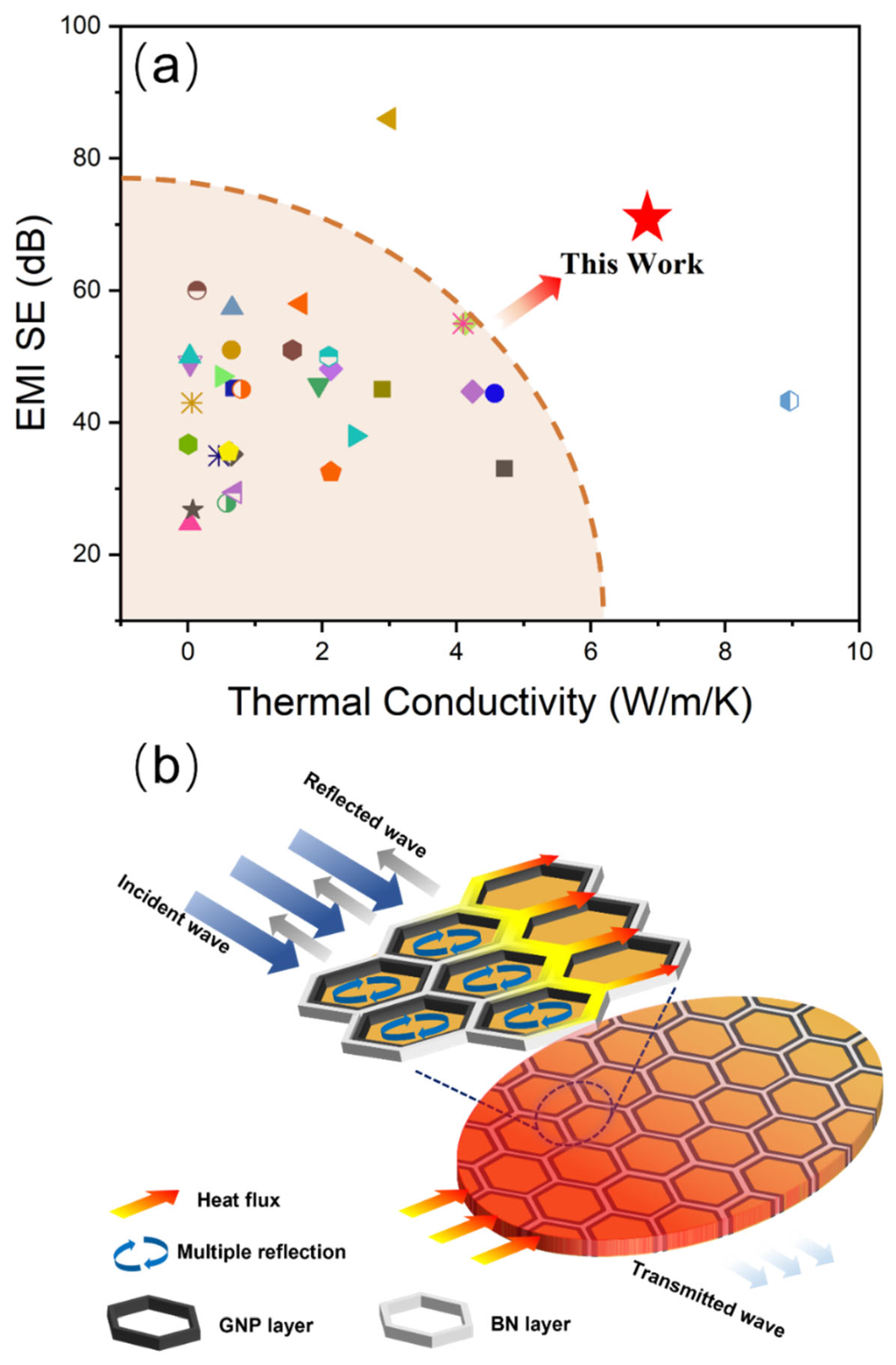
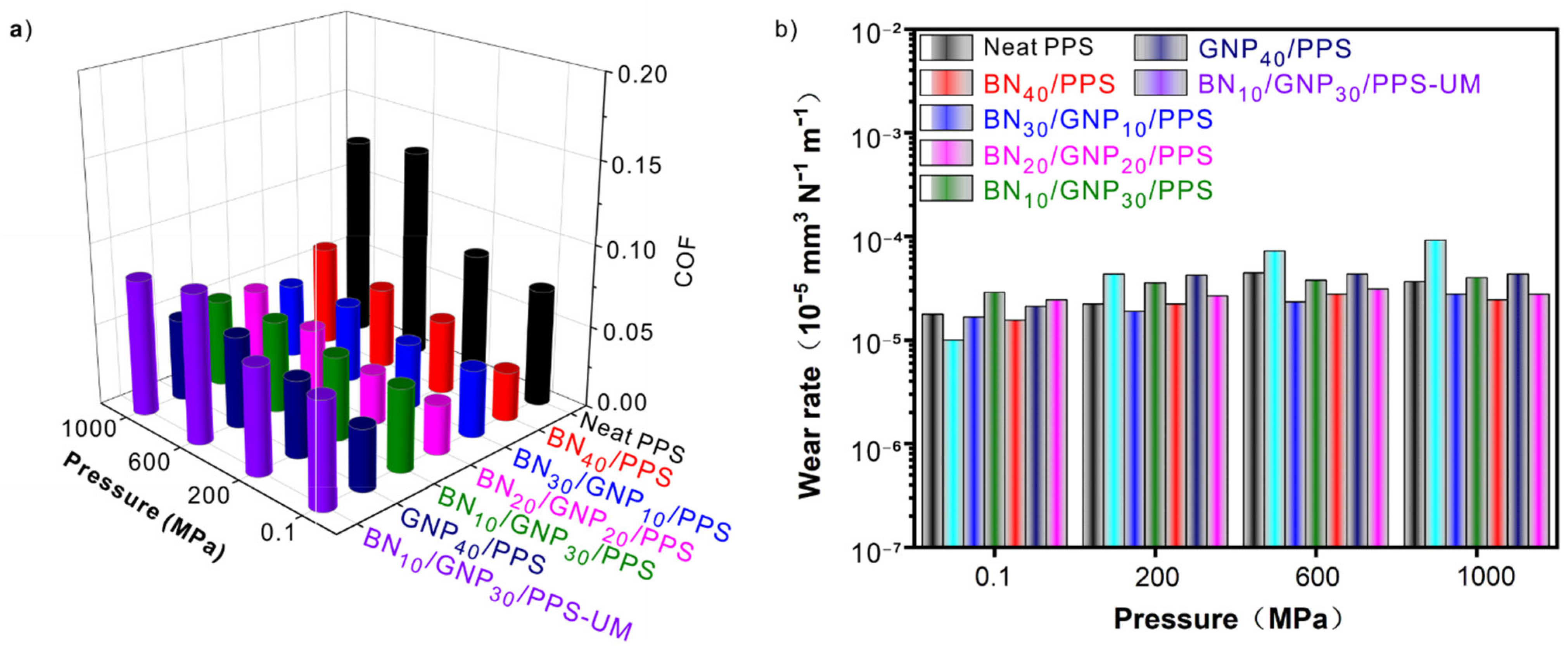
Publisher’s Note: MDPI stays neutral with regard to jurisdictional claims in published maps and institutional affiliations. |
© 2022 by the authors. Licensee MDPI, Basel, Switzerland. This article is an open access article distributed under the terms and conditions of the Creative Commons Attribution (CC BY) license (https://creativecommons.org/licenses/by/4.0/).
Share and Cite
Zhang, L.; Yang, S.; Peng, L.; Zhong, K.; Chen, Y. Optimized Properties in Multifunctional Polyphenylene Sulfide Composites via Graphene Nanosheets/Boron Nitride Nanosheets Dual Segregated Structure under High Pressure. Nanomaterials 2022, 12, 3543. https://doi.org/10.3390/nano12193543
Zhang L, Yang S, Peng L, Zhong K, Chen Y. Optimized Properties in Multifunctional Polyphenylene Sulfide Composites via Graphene Nanosheets/Boron Nitride Nanosheets Dual Segregated Structure under High Pressure. Nanomaterials. 2022; 12(19):3543. https://doi.org/10.3390/nano12193543
Chicago/Turabian StyleZhang, Liangqing, Shugui Yang, Longgui Peng, Kepeng Zhong, and Yanhui Chen. 2022. "Optimized Properties in Multifunctional Polyphenylene Sulfide Composites via Graphene Nanosheets/Boron Nitride Nanosheets Dual Segregated Structure under High Pressure" Nanomaterials 12, no. 19: 3543. https://doi.org/10.3390/nano12193543
APA StyleZhang, L., Yang, S., Peng, L., Zhong, K., & Chen, Y. (2022). Optimized Properties in Multifunctional Polyphenylene Sulfide Composites via Graphene Nanosheets/Boron Nitride Nanosheets Dual Segregated Structure under High Pressure. Nanomaterials, 12(19), 3543. https://doi.org/10.3390/nano12193543





